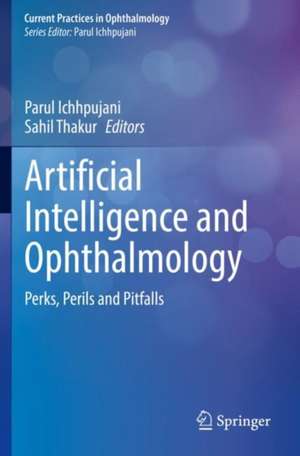Artificial Intelligence and Ophthalmology: Perks, Perils and Pitfalls: Current Practices in Ophthalmology
Editat de Parul Ichhpujani, Sahil Thakuren Limba Engleză Paperback – 24 apr 2022
The book helps to explore the vast expanse of artificial intelligence-based scientific content that has been published in the last few years. Ophthalmology has recently undergone a silent digital revolution, with machine learning and deep learning algorithms consistently outperforming human graders in studies published across the globe. It is high time that a resource that breaks this information behemoth into easily digestible bits comes to the fore. This book simplifies the complex mechanics of algorithms used in ophthalmology and vision science applications. It also tries to address potential ethical issues with machines entering our clinics and patients’ lives. Overall it is essential reading for ophthalmologists/eye care professionals interested in artificial intelligence and everyone who is looking for a deep dive into the exciting world of digital medicine.
| Toate formatele și edițiile | Preț | Express |
|---|---|---|
| Paperback (1) | 696.38 lei 38-44 zile | |
| Springer Nature Singapore – 24 apr 2022 | 696.38 lei 38-44 zile | |
| Hardback (1) | 1093.88 lei 3-5 săpt. | |
| Springer Nature Singapore – 23 apr 2021 | 1093.88 lei 3-5 săpt. |
Preț: 696.38 lei
Preț vechi: 733.04 lei
-5% Nou
Puncte Express: 1045
Preț estimativ în valută:
133.29€ • 144.84$ • 112.04£
133.29€ • 144.84$ • 112.04£
Carte tipărită la comandă
Livrare economică 17-23 aprilie
Preluare comenzi: 021 569.72.76
Specificații
ISBN-13: 9789811606366
ISBN-10: 9811606366
Pagini: 150
Ilustrații: VII, 150 p. 14 illus., 8 illus. in color.
Dimensiuni: 155 x 235 mm
Ediția:1st ed. 2021
Editura: Springer Nature Singapore
Colecția Springer
Seria Current Practices in Ophthalmology
Locul publicării:Singapore, Singapore
ISBN-10: 9811606366
Pagini: 150
Ilustrații: VII, 150 p. 14 illus., 8 illus. in color.
Dimensiuni: 155 x 235 mm
Ediția:1st ed. 2021
Editura: Springer Nature Singapore
Colecția Springer
Seria Current Practices in Ophthalmology
Locul publicării:Singapore, Singapore
Cuprins
1 A Clinician's Introduction to Artificial Intelligence.- 2 What you need to know about Artificial Intelligence: Technical Introduction.- 3 Artificial Intelligence and Ophthalmology: An Overview.- 4 Artificial Intelligence in cornea and refractive surgery.- 5 Artificial Intelligence and Cataract.- 6 Artificial Intelligence and Glaucoma.- 7 Artificial Intelligence in Retinal Diseases.- 8 Artificial intelligence in neuro-ophthalmology.- 9 Artificial Intelligence and Other Applications in Ophthalmology and Beyond.- 10 The Economics of Big Data.- 11 Ethics and Artificial Intelligence: The Pandora’s Box.
Notă biografică
An avid researcher, Dr. Ichhpujani has co-authored three books: “Pearls in Glaucoma Therapy”, “Living with Glaucoma”, and “Smart Resources in Ophthalmology”; and has edited another eight: “Expert Techniques in Ophthalmology”, “Glaucoma: Basic and Clinical Perspectives”, “Manual of Glaucoma”, “Clinical Cases in Glaucoma: An Evidence-Based Approach”, “Glaucoma: Intraocular Pressure and Aqueous Dynamics”, “Current Advances in Ophthalmic Technology”, “Glaucoma” and “Ophthalmic Instruments and Surgical Tools”. She is also the Springer series editor for the ‘Current Practices in Ophthalmology’ series. She has also contributed several research articles and book chapters in national and international books and serves as a reviewer for many ophthalmology journals. She is heavily involved in resident and fellow teaching.
Dr. Sahil Thakur (MBBS, MS) graduated from Government Medical College and Hospital, Chandigarh, India. He is currently a clinical research fellow at the Singapore Eye Research Institute. Apart from pursuing clinical ophthalmology, he has a keen interest in developing affordable medical technology and clinical photography. He is also involved in the research and development ofdigital solutions for faster and efficient diagnosis of common ophthalmic disorders. Previously he has co-authored a book, ‘Smart Resources in Ophthalmology: Applications and Social Networking’ and has more than 50 peer-reviewed publications. Dr. Thakur also has an interest in developing tools for ophthalmic education and has published two Android applications (Ophthalmaster and Ophthalminion) for use by residents and medical school students.
Textul de pe ultima copertă
The book helps to explore the vast expanse of artificial intelligence-based scientific content that has been published in the last few years. Ophthalmology has recently undergone a silent digital revolution, with machine learning and deep learning algorithms consistently outperforming human graders in studies published across the globe. It is high time that a resource that breaks this information behemoth into easily digestible bits comes to the fore. This book simplifies the complex mechanics of algorithms used in ophthalmology and vision science applications. It also tries to address potential ethical issues with machines entering our clinics and patients’ lives. Overall it is essential reading for ophthalmologists/eye care professionals interested in artificial intelligence and everyone who is looking for a deep dive into the exciting world of digital medicine.
Caracteristici
Provides ophthalmologists with a simplified introduction to artificial intelligence and digital medicine Provides clinically relevant content to ask the right questions and have the right expectations from artificial intelligence Addresses potentially critical, ethical issues associated with the use of algorithms in clinics Includes a uniform chapter design with simplified diagrams and tables to highlight important points












